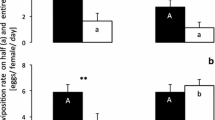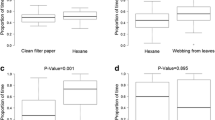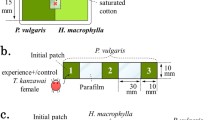Abstract
We examined voluntary-falling behaviour by adult females of the two-spotted spider mite Tetranychus urticae Koch (Acari: Tetranychidae) and one of its major predators Neoseiulus californicus McGregor (Acari: Phytoseiidae). Experiments were conducted using a setup in which mites could only move onto one of two landing points by falling. Significantly more T. urticae females fell onto available food leaves compared to non-food or heavily infested leaves, whereas significantly fewer females fell onto leaves with the predatory mite N. californicus compared to leaves without the predator. This suggests that spider mites can actively choose on which patch to land on the basis of food quality and predation risk on the patch. Using the same experimental setup, starved N. californicus females never fell, suggesting that falling T. urticae females gain the potential advantage of predator avoidance.


Similar content being viewed by others
References
Castagnoli M, Simoni S, Pintucci M (1995) Response of a laboratory strain of Amblyseius californicus (McGregor)(Acari Phytoseiidae) to semi-natural outdoor conditions. Redia (Firenze) 78:273–282
Croft BA, Jung C (2001) Phytoseiid dispersal at plant to regional levels: a review with emphasis on management of Neoseiulus fallacies in diverse agroecosystems. Exp Appl Acarol 25:763–784
Davenport J (1994) How and why do flying fish fly. Rev Fish Biol Fisher 4:184–214
Dicke M (1986) Volatile spider-mite pheromone and host-plant kairomone, involved in spaced-out gregariousness in the spider mite Tetranychus urticae. Physiol Entomol 11:251–262
Duffner K, Schruft G, Guggenheim R (2001) Passive dispersal of the grape rust mite Calepitrimerus vitis Nalepa 1905 (Acari, Eriophyoidea) in vineyards. J Pest Sci 74:1–6
Haemig PD (1997) Effects of birds on the intensity of ant rain: a terrestrial form of invertebrate drift. Anim Behav 54:89–97
Jia F, Margolies DC, Boyer JE, Charlton RE (2002) Genetic variation in foraging traits among inbred lines of a predatory mite. Heredity 89:371–379
Lawson DS, Nyrop JP, Dennehy TJ (1996) Aerial dispersal of European red mites (Acari: Tetranychidae) in commercial apple orchards. Exp Appl Acarol 20:193–202
Li J, Margolies DC (1993) Effects of mite age, mite density, and host quality on aerial dispersal behavior in the two spotted spider mite. Entomol Exp Appl 68:79–86
Losey JE, Denno RF (1998) The escape response of pea aphids to foliar-foraging predators: factors affecting dropping behaviour. Ecol Entomol 23:53–61
Magalhães S, Janssen A, Hanna R, Sabelis MW (2002) Flexible antipredator behaviour in herbivorous mites through vertical migration in a plant. Oecologia 132:143–149
Margolies DC, Kennedy GG (1985) Movement of the two-spotted spider mite Tetranychus urticae Koch (Acari: Tetranychidae), among hosts in a corn-peanut agroecosystem. Entomol Exp Appl 37:55–61
Mitchell R (1973) Growth and population dynamics of a spider mite (Tetranychus urticae K., Acarina: Tetranychidae). Ecology 54:1349–1355
Oku K, Yano S, Takafuji A (2002) Different maternal effects on offspring performance in Tetranychid mites, Tetranychus kanzawai and T. urticae (Acari: Tetranychidae). Appl Entomol Zool 37:425–429
Oku K, Yano S, Osakabe Mh, Takafuji A (2003) Spider mites assess predation risk by using the odor of injured conspecifics. J Chem Ecol 29:2609–2613
Pallini A, Janssen A, Sabelis MW (1997) Odour-mediated responses of phytophagous mites to conspecific and heterospecific competitors. Oecologia 110:179–185
Pels B, Sabelis MW (1999) Local dynamics, overexploitation and predator dispersal in an acarine predator–prey system. Oikos 86:573–583
Penman DR, Chapman RB (1983) Fenvalerate-induced distributional imbalances of two-spotted spider mite on bean plants. Entomol Exp Appl 33:71–78
Saito Y (1977) Study on spinning behavior of spider mites (Acarina: Tetranychidae). I. Method for quantitative evaluation of the mite webbing, and the relationship between webbing and walking. Jpn J Appl Entomol Zool 21:27–34 (in Japanese, with English summary)
Shimoda T, Ozawa R, Sano K, Yano E, Takabayashi J (2005) The involvement of volatile infochemicals from spider mites and from food-plant in prey location of the generalist predatory mite Neoseiulus californicus. J Chem Ecol 31:2019–2032
Smitley DR, Kennedy GG (1985) Photo-oriented aerial-dispersal behavior of Tetranychus urticae (Acari: Tetranychidae) enhances escape from the leaf surface. Ann Entomol Soc Am 78:609–614
Suiter KA, Gould F (1994) Physiological resistance and behavioral avoidance responses to residues of 4 pesticides by 6 spider-mite populations. Entomol Exp Appl 71:1–14
Uesugi R, Sasawaki T, Osakabe Mh (2009) Evidence of a high level of gene flow among apple trees in Tetranychus urticae. Exp Appl Acarol 49:281–290
Washburn JO, Washburn L (1984) Active aerial dispersal of minute wingless arthropods: exploitation of boundary-layer velocity gradients. Science 223:1088–1089
Yano S (2008) Collective and solitary behaviors of the two-spotted spider mite (Acari: Tetranychidae) are induced by trail following. Ann Entomol Soc Am 101:247–252
Yano S, Osakabe Mh (2009) Do spider mite-infested plants and spider mite trails attract predatory mites? Ecol Res 24:1173–1178
Acknowledgements
We thank D. E. Bowler and other members of the Laboratory of Ecological Information for valuable suggestions and encouragement. We also thank anonymous reviewers for their helpful suggestions. This work was supported by the Japan Society for the Promotion of Science [Basic Research C; grant number 21580066 to S. Y.].
Author information
Authors and Affiliations
Corresponding author
Rights and permissions
About this article
Cite this article
Ohzora, Y., Yano, S. Voluntary Falling in Spider Mites in Response to Different Ecological Conditions at Landing Points. J Insect Behav 24, 274–281 (2011). https://doi.org/10.1007/s10905-010-9253-5
Revised:
Accepted:
Published:
Issue Date:
DOI: https://doi.org/10.1007/s10905-010-9253-5




